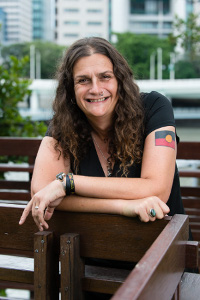
Claire’s writing has been called ‘arresting and original’, re-defining the boundaries of genre to create novels that surprise and delight. Claire is set to take us through this fascinating area in Blending Genre on March 20.
We talked to Claire about the appeal of bending and blending genre, and the writing life.
Writers SA: Hi Claire, can you tell our readers a little about yourself and your writing?
Claire G. Coleman: I am a Noongar woman, born in Perth and living mostly in Melbourne. My writing has always been a tool to unpack colonization and its effects in Australia.
What is your writing routine?
I get up at 5am pretty much every morning and write until either I have to go somewhere of until I finish what has to be done. On really bad weeks that can be 11pm so I can sometimes have a pretty long working day.
The Old Lie and Terra Nullius are award-winning bestsellers at the forefront of speculative fiction/sci-fi in Australia – what drew you to those genres?
I have always been a fan of science fiction, fantasy and speculative fiction and when I write I think in the tropes and structures of those genres.
Your prose often reads like poetry, and your work has been described as literary, historical, speculative and science fiction; what is your approach to genre?

How useful do you think genre labels are for your own fiction, and more widely?
Genre labels are useful as they help people find books they like, but they are problematic as they are hierarchical, with “contemporary realist” fiction being seen as superior to speculative genres. Also, they are a problem for me because bookshops don’t know where to put my books.
What genres and authors have most influenced your writing?
I have been strongly influenced by science fiction such as Sheri S Tepper and poetry such as Dorothy Porter.
What are genre-blending or bending books that you’d recommend?
The Monkey’s Mask by Dorothy Porter which is a detective story in verse. Frankenstein, the old classic, bent genre because it existed before the genres did. Frankenstein, frankly, is a blend of sci-fi and horror before sci-fi existed and when horror had always been supernatural. There are so many works that would never have existed without Mary Shelley.
Many of our readers are curious about your workshop – can you give them an idea of what to expect?
I have had much success in breaking the genre conventions and, to an extent, changing how genres are seen in the Australian literary landscape. I hope I can aid the attendees to the workshop in doing that themselves.
Any favourite words/phrases? Least favourite?
My favourite word changes constantly. My favourite word this week is “historiography” because no other word says quite as much as it about what’s wrong with our understanding of the word. My least favourite today is “then” because it’s the word I have found myself using too much recently and I hate overusing daggy words.
Semicolon.
Em or en dash?
Both, they are so different.
Best writing snack?
Prosciutto and cheese.
What are you working on next?
I have three major works on the go, editing a book of non-fiction, editing my third novel and developing/editing a genre-bending play. That’s probably enough but I have ideas for another couple of novels on the go.
Book into Blending Genre with Claire G. Coleman here. Read more about Claire and her work here.








